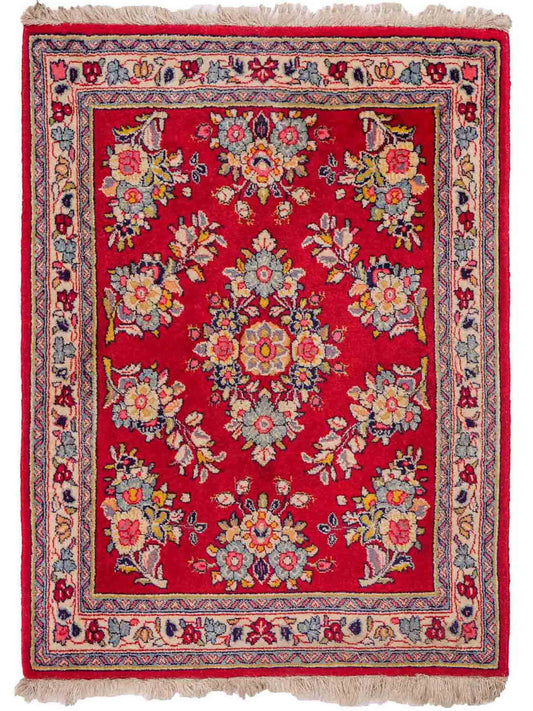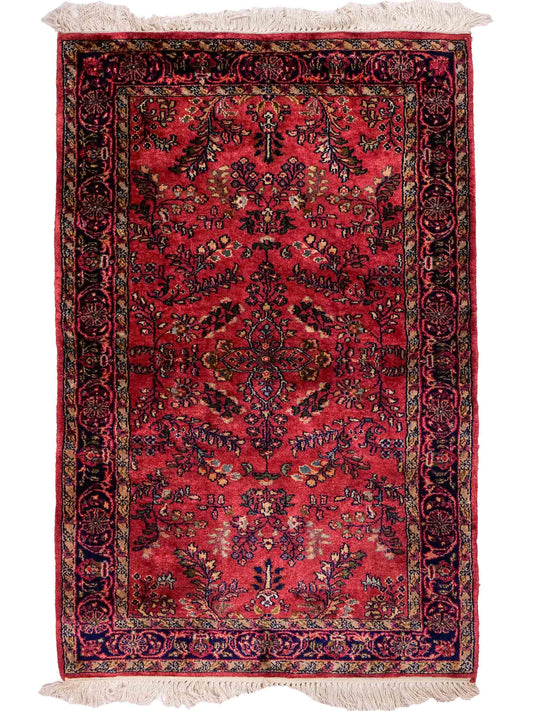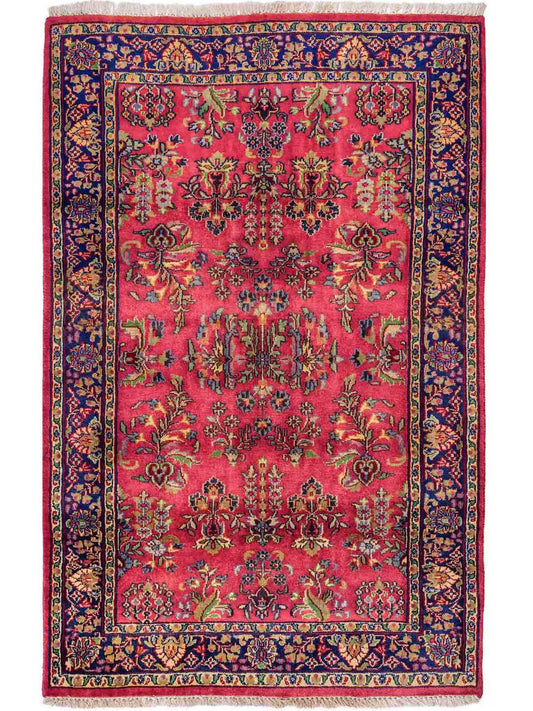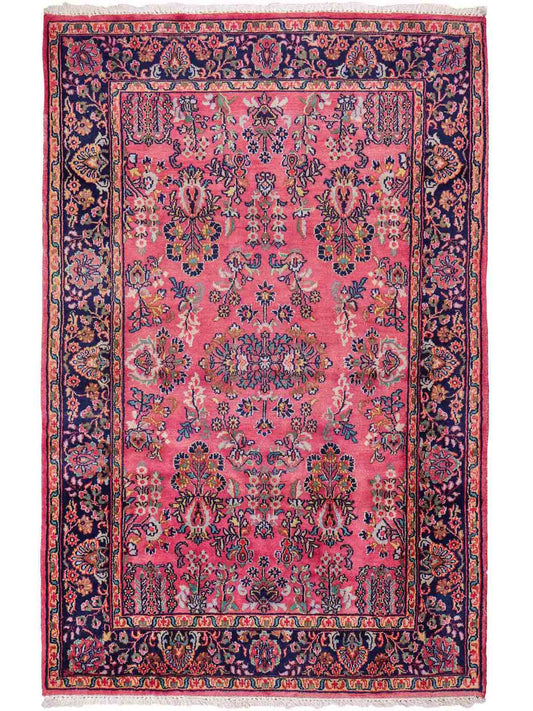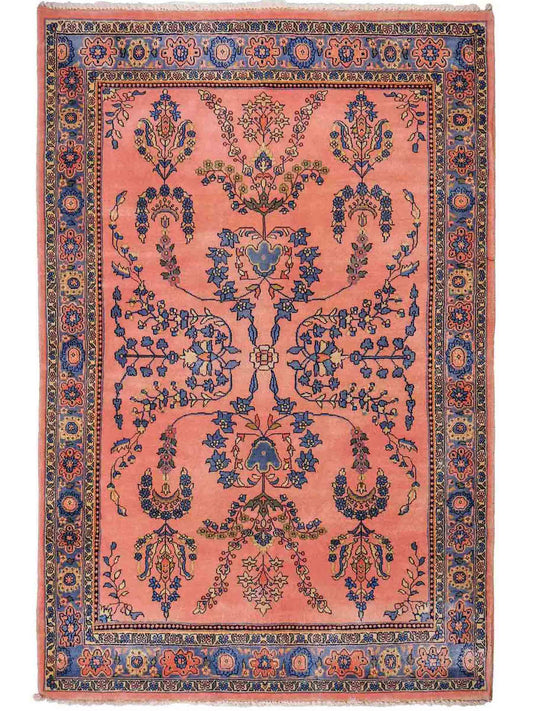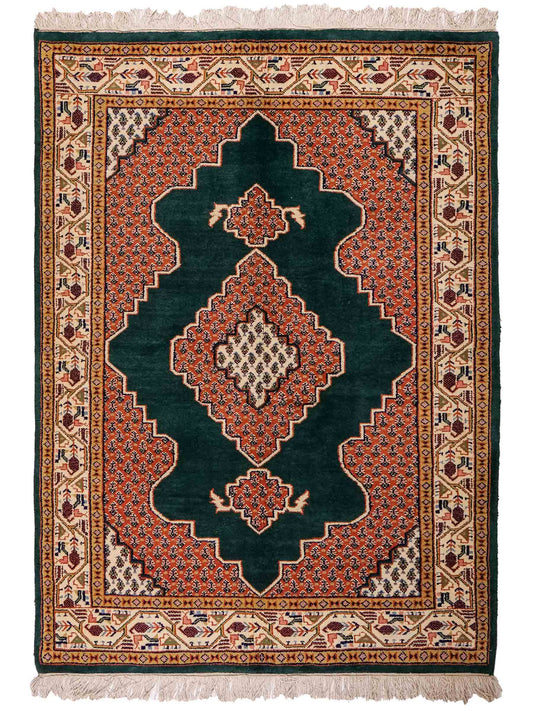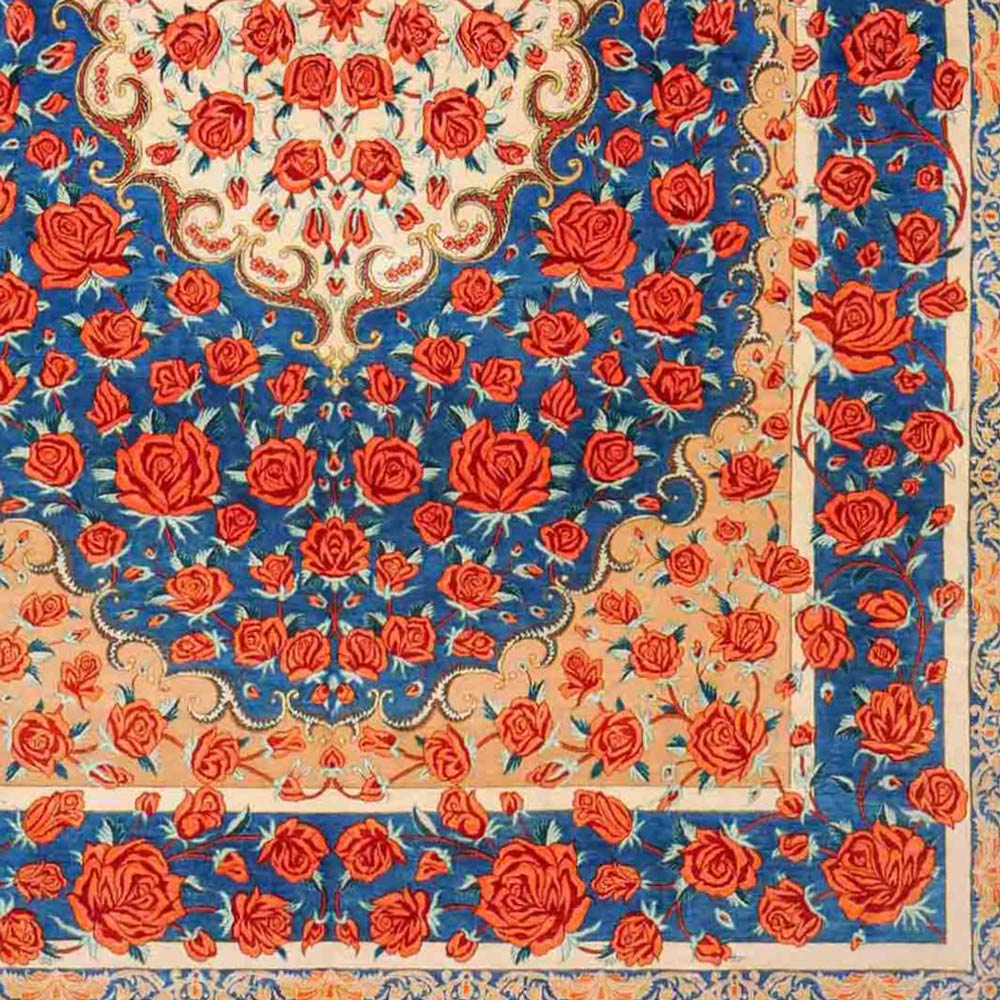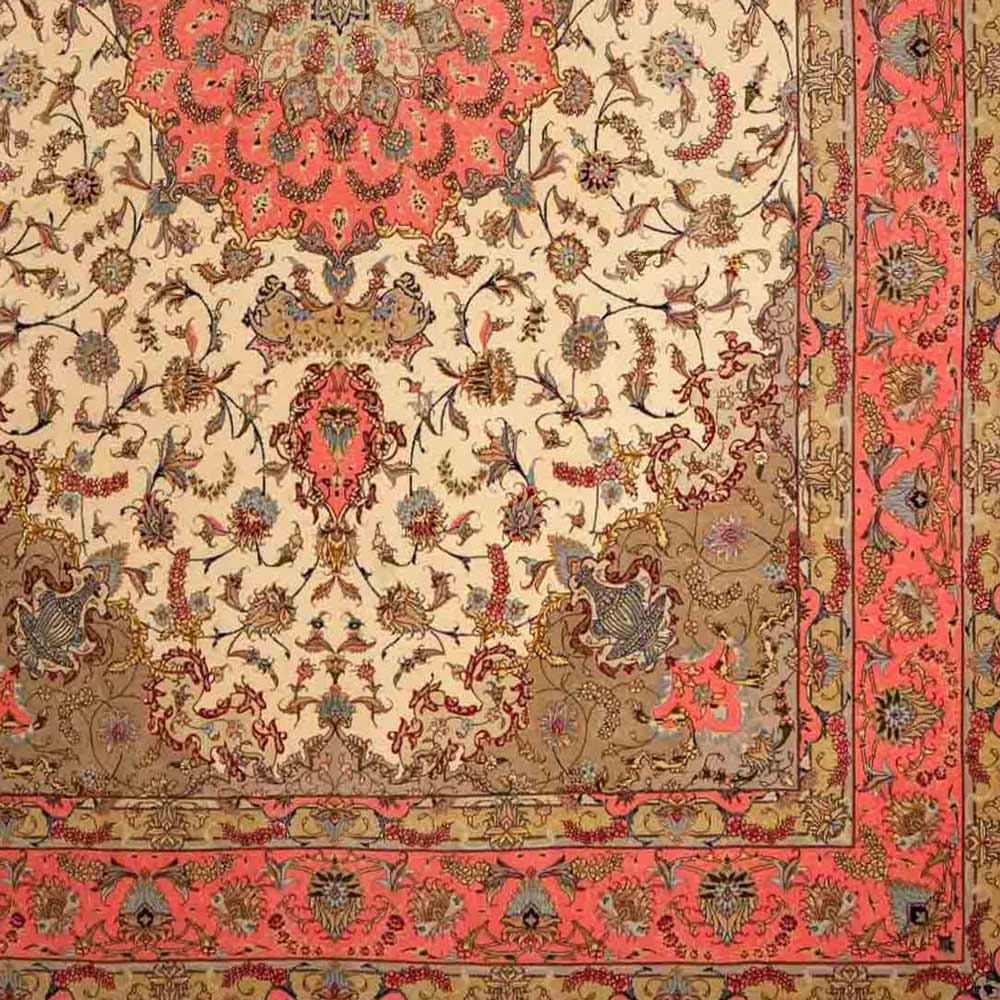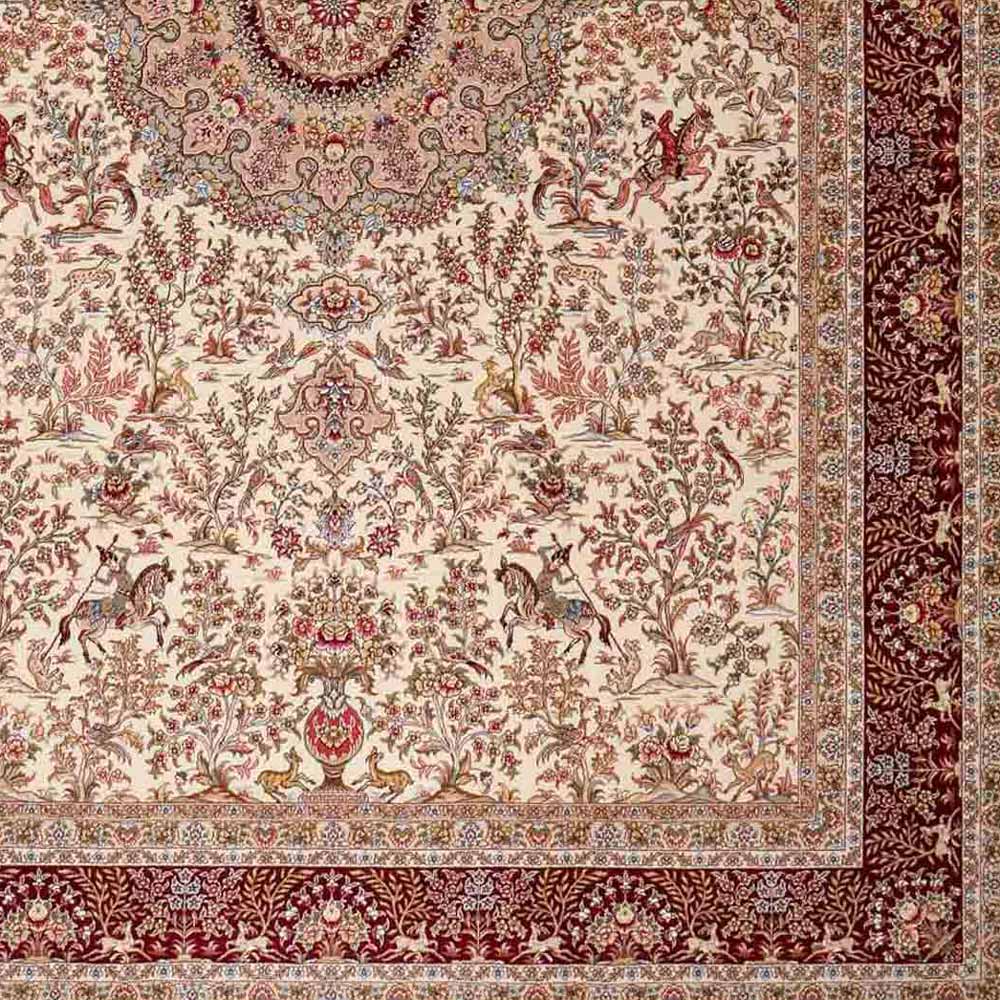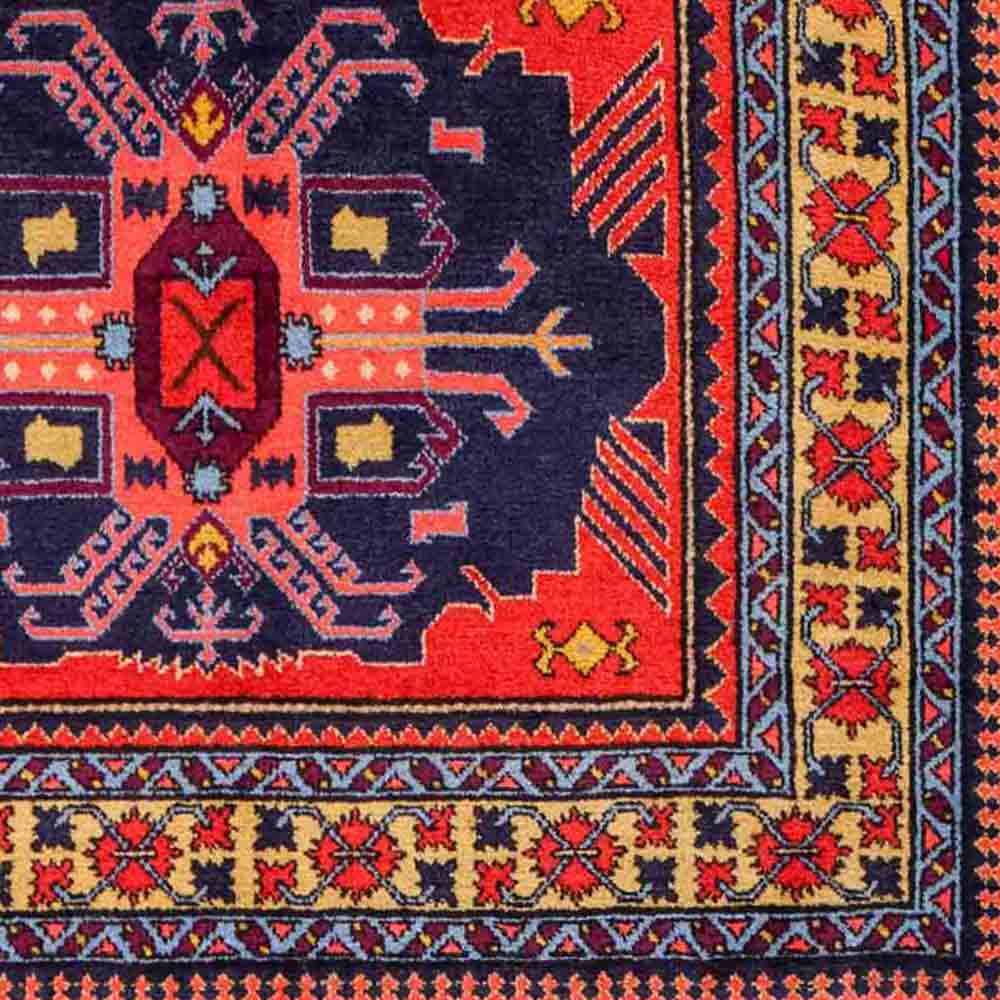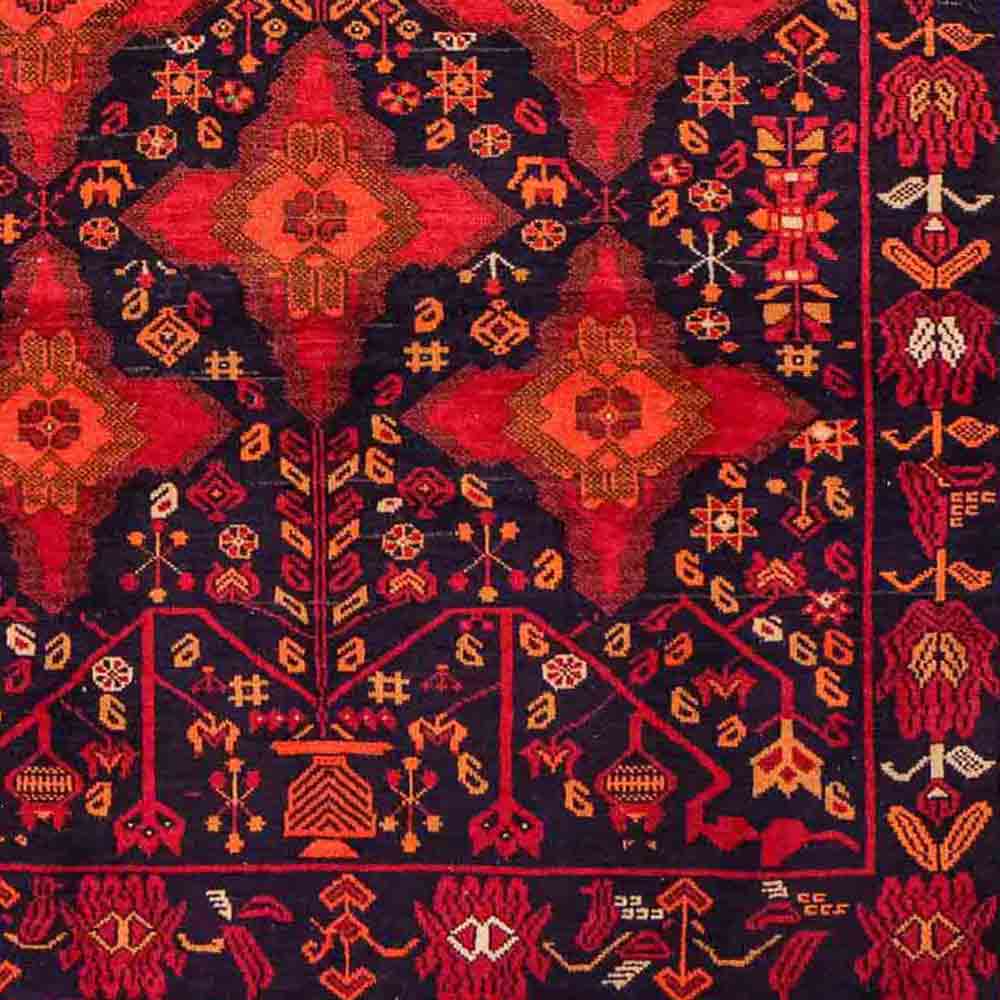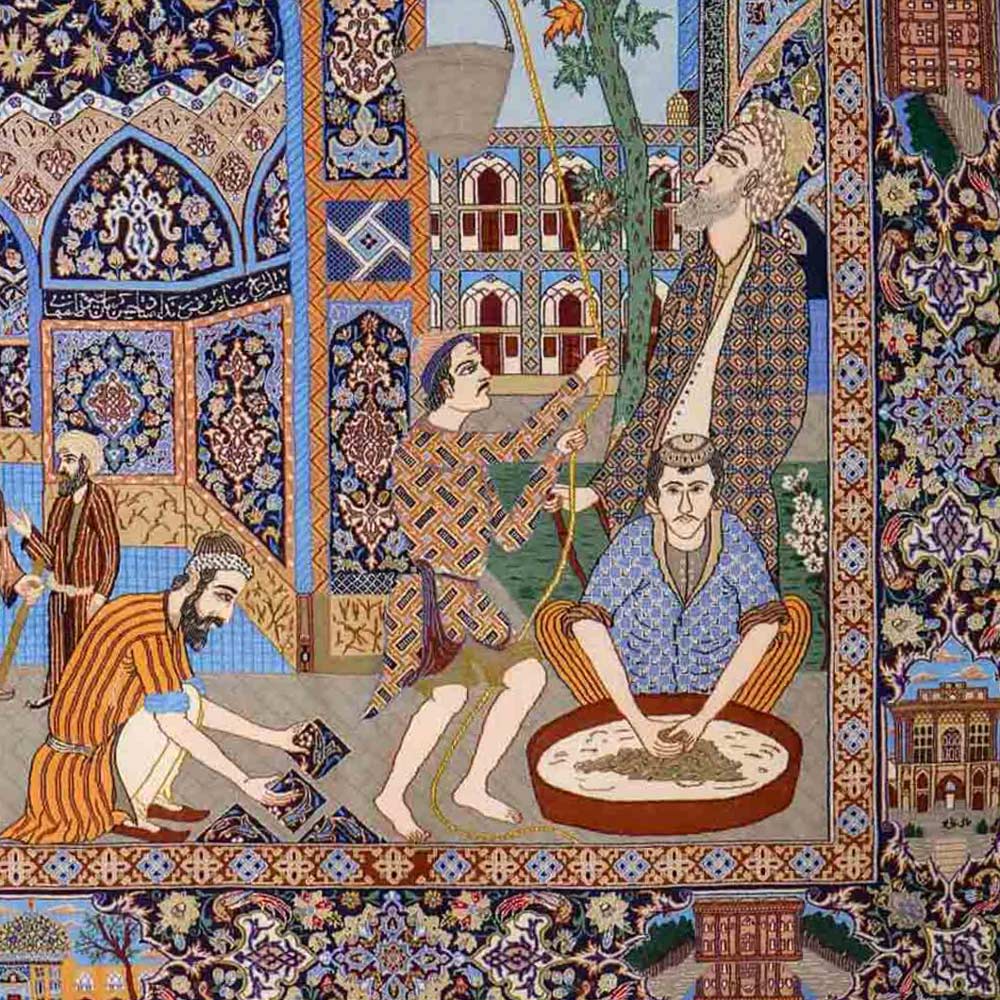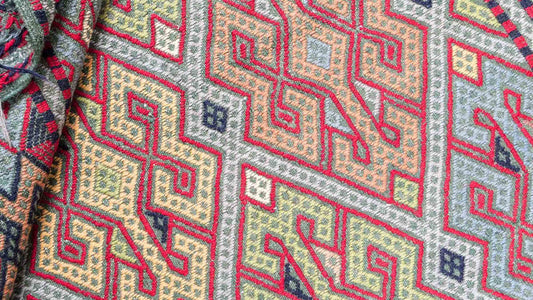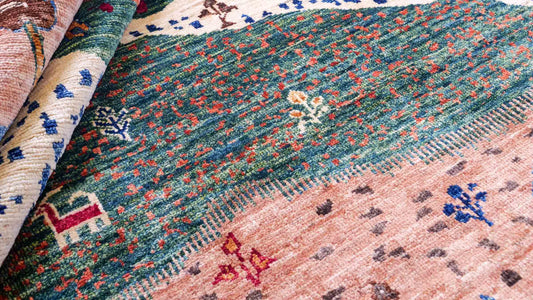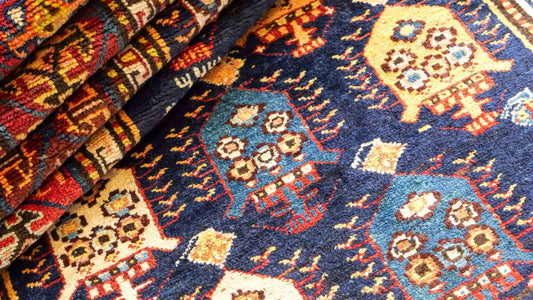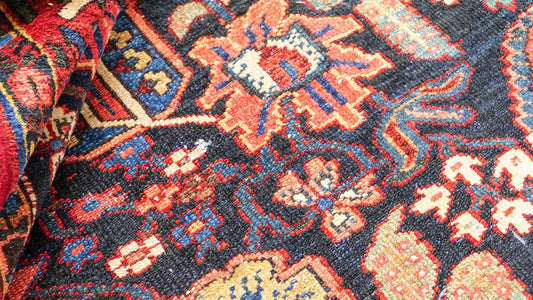
Sarouk
Daniel KhademiWelcome to the fascinating world of Sarouk rugs – hand-knotted masterpieces from Persia, renowned for their quality, variety, and cultural significance. In this article, you will learn everything about their origins, design, manufacturing, and the investment opportunities surrounding these impressive rugs.
Sarouk Rugs: At a Glance
- Origin: Northwest Iran, Markazi Province, near Arak
- Material: High-quality wool
- Knot density: 160,000 – 400,000 knots/m² (up to 600,000 for luxury pieces)
- Design: Geometric patterns, floral motifs, medallions, mythological scenes
- Colors: Red, blue, earth tones, natural dyes
- Special features: High quality, durable, exclusive, ideal as an investment
- Use: In both classic and modern interiors
Explore our curated collection of exclusive Sarouk Rugs & Designs —find your one-of-a-kind masterpiece today!
Origin & Geographical Roots
The Center of Iranian Rug Art in Sarouk
Sarouk is located in the northwest of Iran, near the city of Arak, in Markazi Province. This region is defined by its central location in Iran and is surrounded by several mountain ranges, including the Zagros Mountains to the south and the Alborz Mountains to the north. The fertile landscape is complemented by a network of rivers and streams, such as the Zayandeh Rud River which flows through the eastern part of the province, allowing for a diverse agriculture.
The area around Sarouk features numerous villages and small towns whose inhabitants often maintain more traditional ways of life. The climate, marked by hot summers and cold winters, also affects the crops that thrive here, including fruit, vegetables, and grain.
The region is well known for its rich cultural history and its role in tea cultivation and wool production. The presence of sheep herds and the long-standing tradition of sheep farming provide the necessary wool for rug weaving.
The rug art of Sarouk is an example of the union of nature, culture, and craftsmanship. The rugs are famed for their vibrant colors and geometric patterns, often inspired by local myths and stories. These features, together with the geographical location, make Sarouk a top origin for rugs distinguished by high quality and artisanal skill.
History of Sarouk Rugs
From Nomadic Tradition to Global Recognition
The history of Sarouk rugs dates back to the 19th century. Production originally began as part of local art and culture, strongly influenced by the nomadic peoples such as the Qashqai and Bakhtiari. These nomadic tribes brought their own rug traditions to the region, which are reflected in Sarouk designs and techniques.
In the 19th century, the region experienced a golden era as rug merchants began to market their creations beyond Iran's borders. This era coincided with the rise of the Iranian rug industry, which benefited greatly from European industrialization and the resulting trade relationships. Sarouk rugs found their way to markets in Europe and North America, where they quickly gained popularity. This fame led to the development of a distinctive Sarouk style, notable for a combination of traditional patterns and more modern design approaches.
In the early 20th century, rug production in Sarouk underwent another boom, when European designers and traders discovered the region and encouraged artisans to create rugs with contemporary motifs. This resulted in further diversification of designs and a broader palette of colors and styles.
While fashions and techniques have evolved over time, the roots and traditions of fine craftsmanship have remained. The artisans of Sarouk are proud of their history and heritage, passing down their expertise to the next generation through practical instruction. Even today, Sarouk rugs are prized for their exceptional quality and aesthetic design, making them a vital part of Iran’s cultural heritage.
In recent decades, however, the rug industry has faced challenges, including competition from machine-made textiles and the decline of traditional crafts. Nevertheless, the production of Sarouk rugs remains a symbol of the region’s cultural heritage and identity. The artisans strive to preserve traditional techniques while finding new ways to present their art to a global market.
Manufacturing of Sarouk Rugs
The creation of a Sarouk rug is a time-intensive and carefully crafted process involving several steps. The rugs are made from high-quality sheep’s wool, prized for its durability and vibrancy of color. The process begins with selecting wool from local sheep, which are usually shorn in the spring.
- Cleaning and Dyeing: After shearing, the wool is thoroughly cleaned to remove impurities. It is then dyed using natural colorants derived from plants, minerals, or insects. These traditional dyeing techniques ensure vibrant, sustainable colors that do not fade over time.
- Knotting Technique: The knotting technique used is usually the Persian knot, also called the Senneh knot. This method allows for a high knot density, which in Sarouk rugs often ranges from about 160,000 to 400,000 knots per square meter. The higher the knot count, the finer and more detailed the rug’s pattern. Compared to other provinces like Qom or Isfahan, Sarouk rugs tend to be knotted a little coarser, which enhances their handmade charm and gives Sarouk rugs their distinctive aesthetic.
- Weaving Process: During the weaving process, the strength of the foundation (the warp) and the dyeing of the wool are carefully monitored. The weavers often work with precise templates or pattern cards that define design and color distribution. The skilled craftsmen knot the wool thread by thread, requiring great skill and precision.
- Finishing: After knotting, the rug is thoroughly cleaned to remove leftover wool fibers and dirt. The fringes are then finished and the edges trimmed to ensure a uniform look. The rugs are often dried and, depending on the design, may be dyed or treated again to achieve the desired sheen.
- Quality Control: The final step is a thorough quality inspection, where the rug is checked for defects or irregularities. Only rugs that meet the highest standards are offered for sale.
Classic Sarouk Designs & Patterns
Sarouk rugs are famous for their rich variety of designs and patterns, deeply rooted in the history and culture of the region. The most common motifs include:
- Floral Patterns: These are among the most characteristic features of Sarouk rugs. They incorporate stylized flowers, leaves, and vines, often arranged symmetrically. The floral designs are usually created to convey a sense of motion and vibrancy, many inspired by traditional Persian gardens.
- Geometric Elements: In addition to floral motifs, geometric shapes are frequently used to provide structured balance to the softer floral motifs. These may appear as diamonds, rectangles, or other polygons, enhancing the design versatility.
- Central Medallion: A common feature of Sarouk rugs is the central medallion, often surrounded by various patterns or decorative elements. This medallion acts as a visual focal point and draws the eye, creating a harmonious composition.
- Mythological and Historical Motifs: Some rugs feature specific scenes or symbols associated with the rich mythology or history of Iran. These may include animals, stylized human figures, or scenes from Persian literature, helping to tell stories and preserve the region’s cultural identity.
These patterns are often harmonious and exhibit an understated elegance that appeals to both traditional and modern tastes. The repeated design motifs not only enhance the identity of Sarouk rugs but also create a sense of continuity and tradition.
Traditional Colors of Sarouk Rugs
The color palette of Sarouk rugs is extensive, with many hues reflecting the beauty of nature. More details about the use of color:
- Reds: Red is considered one of the most symbolically powerful colors in Persian culture, representing energy, passion, and vibrant emotion. Sarouk rugs feature an impressive range of reds, from deep burgundy and ruby to lively crimson and soft terracotta. This spectrum allows for red to be used both as a dominant and as an accent color, often combined with other tones like blue or cream. The intense coloring is eye-catching and gives the rug its particular radiance, making the designs vivid and impressive.
- Earth Tones: Earth tones are an important part of the Sarouk color palette and contribute to the natural look of the designs. Along with vibrant colors like red and blue, shades such as terracotta, brown, beige, and ochre are also commonly found. They endow the rugs with a warming, inviting appeal and a sense of security. Browns range from pale sand tones to deep chocolate, helping to balance bolder colors. These shades integrate seamlessly into different interior concepts, making the rugs versatile – whether in rustic country homes or modern living spaces. Ultimately, earth tones foster a connection to the natural materials and colors of the environment.
- Color Gradients: Many Sarouk rugs use gradients that allow a gentle transition between lighter and darker shades. This technique gives their rugs depth and dimension, allowing them to appear different under varying lighting conditions.
- Use of Natural Substances: Dyeing with natural colorants from plants, roots, and minerals makes the colors not only environmentally friendly but also imparts a vibrancy that chemically dyed wool seldom achieves. Over time, these techniques lead to colors developing deeper and richer tones.
- Cultural Symbolism: The colors used also often carry cultural significance. For example, in many Asian cultures, red stands for luck and prosperity, while blue symbolizes calm and peace. This gives each rug an additional layer of meaning.
In conclusion, the diversity of patterns and careful use of color in Sarouk rugs reflect not only the artisans’ craftsmanship but also the region’s cultural values and stories. This combination makes them unique works of art that serve not only as functional objects in any living space, but also as expressions of cultural identity.
Design Classics Compared: Bijar, Sarouk, Kashan & Mashhad Rugs
| Feature | Bijar | Sarouk | Kashan | Mashhad |
| Origin | Northwest Iran, Kurdistan | Northwest Iran, Markazi | Central Iran, Isfahan |
Northeast Iran, Khorasan |
| Material | High-quality sheep wool | High-quality sheep wool | High-quality sheep wool, rarely silk | High-quality sheep wool |
| Knot density | 250,000 – 600,000 knots/m² | 160,000 – 400,000 knots/m² | 120,000 – 600,000 knots/m² | 200,000 – 500,000 knots/m² |
| Design | Geometric, floral, medallion | Geometric, floral, medallion | Geometric, floral, medallion | Geometric, floral, medallion |
| Colors | Reds, blues, earth tones | Reds, blues, earth tones | Reds, blues, earth tones, greens | Reds, blues, earth tones, greens, golds |
| Special features | Very hard-wearing, dense knots, strong colors | Vibrant colors, geometric & floral motifs | Natural dyes, classic, durable | High-quality wool, diverse designs |
| Value/Price range | Premium segment, highly value-stable | Premium segment, highly value-stable | Premium segment, highly value-stable | Mid to premium segment |
Checklist for Sarouk Rugs: Quality & Authenticity
- High-quality wool used? ✔
- Natural dyes from plants or minerals? ✔
- Knot density: at least 160,000 knots/m²? ✔
- Hand-knotted using traditional technique? ✔
- Pattern clearly visible on the reverse side? ✔
- Edges and fringes neatly finished? ✔
- No chemical odor? ✔
- Certificate or proof of origin provided? ✔
Styling Tips: Decorating with Sarouk Rugs
Sarouk rugs are enjoying growing popularity worldwide and adapt to current trends such as sustainability and ethical production. Their handmade quality, versatile designs, and wide color palette make them ideal home accessories for a variety of interior styles – whether classic, minimalist, or modern. Especially in high-traffic areas like living rooms, hallways, or home offices, they make stylish as well as practical statements.
Care & Longevity: Preserving Your Sarouk Rug
How to Keep Your Sarouk Rug Beautiful for Years:
- Vacuum regularly, but do not beat
- Treat stains immediately with lukewarm water & a cloth
- Avoid direct sunlight
- Professional cleaning recommended every 1–2 years
- Find more care tips in our blog post: *How to Care for Hand-Knotted Rugs*
Sarouk Rugs as Collectibles & Investments
By purchasing a Sarouk rug, you are investing not only in a beautiful work of art but also in valuable craftsmanship of deeper worth and historical significance.
- Appreciation: Especially high-quality Sarouks have the potential to increase in value over time. This stems from various factors, including knotting technique, material selection, and design rarity. Like many works of art, well-preserved antique Sarouks become sought-after collectibles, commanding significant appreciation on the market and making them attractive as investment assets.
- Collector’s Items: Sarouks are excellent for collectors due to their variety of styles, designs, and sizes. A carefully chosen Sarouk rug not only tells a story but also becomes a treasured heirloom to be passed down through generations.
The market for handmade rugs is steadily growing, as more people recognize the uniqueness and emotional value of craftsmanship. Sarouk rugs unite art, history, and functionality in a unique way. They are not just an asset for any home, but also a valuable item that tells stories and can endure for generations. In a world increasingly dominated by mass production, individually crafted works of art are becoming ever more significant and valuable.
► For detailed tips & in-depth guidance, see our blog post: *Are Hand-Knotted Rugs a Good Investment?*
Request a free personal style or purchasing consultation for Sarouk rugs today!
FAQ – The Most Important Questions about Sarouk Rugs
What makes a real Sarouk rug?
► High-quality wool, natural dyes, high knot count, elaborate handcrafting.
Are Sarouk rugs suitable for everyday use?
► Yes, thanks to robust materials and proper care, they are also suitable for high-traffic rooms.
How do I care for a Sarouk rug properly?
► Vacuum carefully, do not use aggressive – especially not chemical – agents, and avoid direct sunlight. Regular professional cleaning will maintain their beauty and value. More in our blog post: *How to Care for Hand-Knotted Rugs*
How do I recognize a real Sarouk rug?
► A genuine Sarouk is hand-knotted; carefully examine the reverse side. The pile is made from naturally dyed sheep wool. Check for certificates of origin and authenticity.
Is it worth investing in a Sarouk rug?
► Very fine and/or antique Sarouk rugs with distinctive patterns are stable-value collector and connoisseur pieces. Read more in our blog post: *Are Hand-Knotted Rugs a Good Investment?*
Where can I safely buy authentic Sarouk rugs?
► Only from specialist dealers and reputable online shops—always check for certificates of authenticity and expert advice. At JUPITER Intl, every hand-knotted, hand-tufted, and handwoven rug comes with a Certificate of Authenticity.
Conclusion: A Persian Classic for Your Home
By investing in a Sarouk rug, you acquire a piece of Iranian culture and craftsmanship. Its timeless design and artisanal quality blend history, aesthetics, and value retention. Find your personal, one-of-a-kind piece in our shop!
Explore our curated collection of exclusive Sarouk Rugs & Designs —find your one-of-a-kind masterpiece today!
Related blogs & blog posts you might also be interested in:
→ Design Classics, Countries of Origin, Carpet Materials, Carpet Guide

